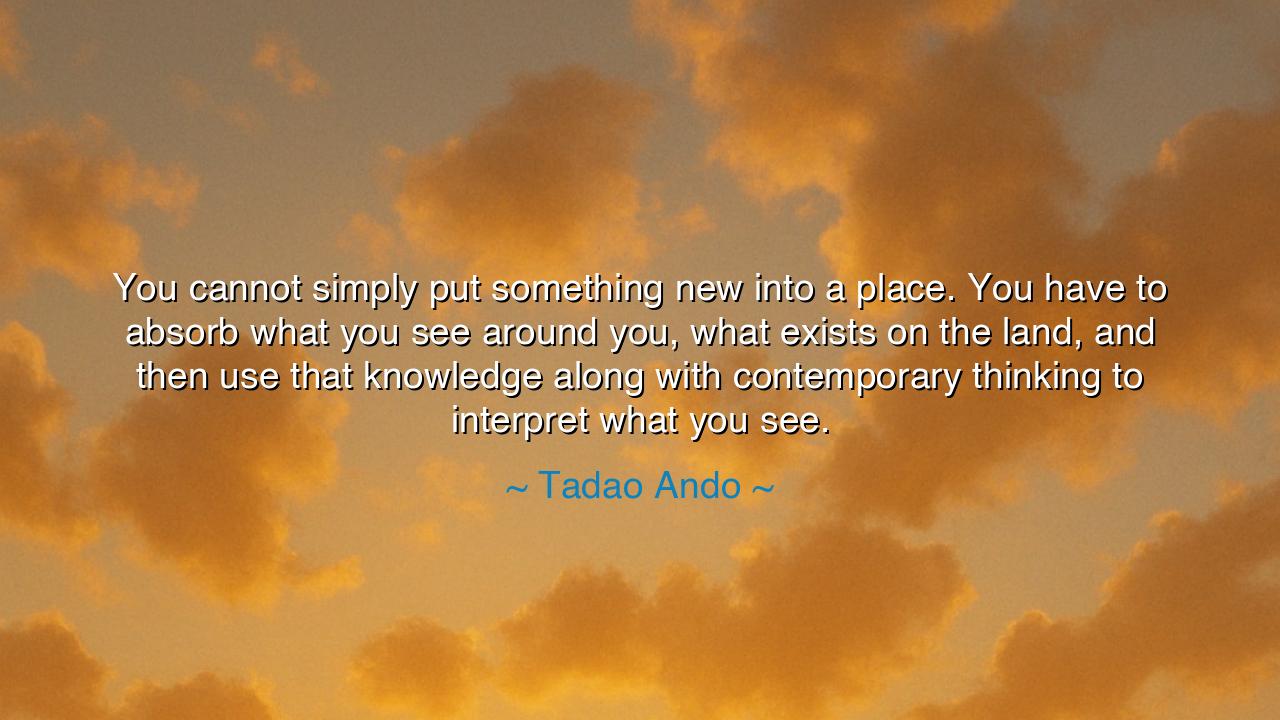
You cannot simply put something new into a place. You have to
You cannot simply put something new into a place. You have to absorb what you see around you, what exists on the land, and then use that knowledge along with contemporary thinking to interpret what you see.






Hear and receive the wisdom of Tadao Ando, the architect who shaped silence into form, who declared: “You cannot simply put something new into a place. You have to absorb what you see around you, what exists on the land, and then use that knowledge along with contemporary thinking to interpret what you see.” These words are not for builders alone, but for all who would create, who would change, who would leave a mark upon the world. For Ando speaks of harmony, of reverence, of the sacred balance between what is old and what is new, between what is given and what is made.
In his words we see the truth: creation is not conquest. To build upon the earth is not to erase, but to listen. The land itself holds stories—the whisper of rivers, the memory of stones, the pattern of winds. One who would shape it must first absorb these voices, drink deeply of what already exists, and only then may he bring forth something new. To ignore the land is to build upon a lie; to honor it is to create something lasting, something true.
Consider the temples of ancient Greece. The builders of the Parthenon did not simply place stone upon a hill. They studied the slopes of the Acropolis, the play of sunlight upon marble, the way the structure would meet the sky. Their work was not an imposition, but an interpretation—a dialogue between human hands and sacred ground. This is why their creation endures: because it was born not only from skill, but from respect.
So too with Ando himself, who shaped concrete into spaces of light and shadow that seem less like intrusions and more like revelations. His knowledge was not only of modern form but of ancient spirit. He built chapels where water, sky, and walls became one; museums where the path itself feels like a meditation. His art teaches that innovation does not discard the past—it listens to it, absorbs it, and transforms it through the lens of the present.
But Ando’s teaching reaches far beyond architecture. In every act of life—whether we build homes, create communities, or shape ideas—we must not simply impose our will. We must first understand what is already there: the people, the history, the rhythms of the place. To disregard them is to plant seeds in barren soil. To honor them is to ensure that what we create takes root, flourishes, and endures.
The lesson is clear: do not rush to force change. First, open your eyes. Absorb what you see. Listen to the land, to the culture, to the lives that came before. Then, and only then, weave your vision with respect, blending what is ancient with what is new. In this way, what you build—whether a house, a relationship, or a society—will not stand against the world, but with it.
So I say to you: walk humbly before creation. Be not the conqueror who imposes, but the interpreter who listens. Seek harmony, not domination. Let your works be born from both knowledge and reverence, from both tradition and contemporary thought. For then, like the temples of old and the works of Ando, what you shape will not merely occupy space, but will belong to it, breathe with it, and endure as a living testament to wisdom.
Thus shall his words guide us: you cannot simply put something new into a place—you must first absorb, then interpret, then create. In this truth lies the secret of building not only structures, but legacies that stand the test of time.






AAdministratorAdministrator
Welcome, honored guests. Please leave a comment, we will respond soon